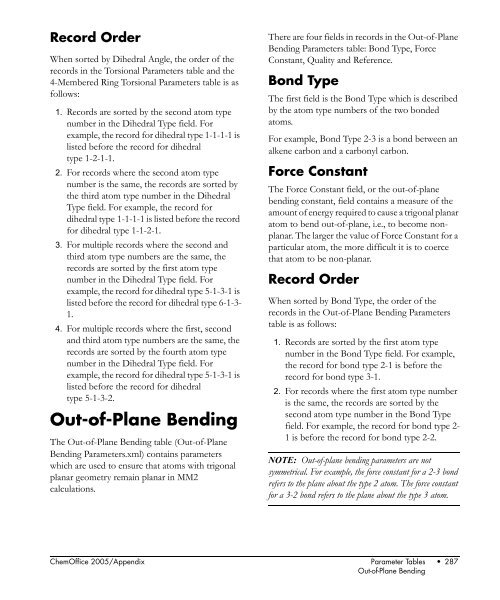Chem3D Users Manual - CambridgeSoft
Chem3D Users Manual - CambridgeSoft
Chem3D Users Manual - CambridgeSoft
Create successful ePaper yourself
Turn your PDF publications into a flip-book with our unique Google optimized e-Paper software.
Record Order<br />
When sorted by Dihedral Angle, the order of the<br />
records in the Torsional Parameters table and the<br />
4-Membered Ring Torsional Parameters table is as<br />
follows:<br />
1. Records are sorted by the second atom type<br />
number in the Dihedral Type field. For<br />
example, the record for dihedral type 1-1-1-1 is<br />
listed before the record for dihedral<br />
type 1-2-1-1.<br />
2. For records where the second atom type<br />
number is the same, the records are sorted by<br />
the third atom type number in the Dihedral<br />
Type field. For example, the record for<br />
dihedral type 1-1-1-1 is listed before the record<br />
for dihedral type 1-1-2-1.<br />
3. For multiple records where the second and<br />
third atom type numbers are the same, the<br />
records are sorted by the first atom type<br />
number in the Dihedral Type field. For<br />
example, the record for dihedral type 5-1-3-1 is<br />
listed before the record for dihedral type 6-1-3-<br />
1.<br />
4. For multiple records where the first, second<br />
and third atom type numbers are the same, the<br />
records are sorted by the fourth atom type<br />
number in the Dihedral Type field. For<br />
example, the record for dihedral type 5-1-3-1 is<br />
listed before the record for dihedral<br />
type 5-1-3-2.<br />
Out-of-Plane Bending<br />
The Out-of-Plane Bending table (Out-of-Plane<br />
Bending Parameters.xml) contains parameters<br />
which are used to ensure that atoms with trigonal<br />
planar geometry remain planar in MM2<br />
calculations.<br />
There are four fields in records in the Out-of-Plane<br />
Bending Parameters table: Bond Type, Force<br />
Constant, Quality and Reference.<br />
Bond Type<br />
The first field is the Bond Type which is described<br />
by the atom type numbers of the two bonded<br />
atoms.<br />
For example, Bond Type 2-3 is a bond between an<br />
alkene carbon and a carbonyl carbon.<br />
Force Constant<br />
The Force Constant field, or the out-of-plane<br />
bending constant, field contains a measure of the<br />
amount of energy required to cause a trigonal planar<br />
atom to bend out-of-plane, i.e., to become nonplanar.<br />
The larger the value of Force Constant for a<br />
particular atom, the more difficult it is to coerce<br />
that atom to be non-planar.<br />
Record Order<br />
When sorted by Bond Type, the order of the<br />
records in the Out-of-Plane Bending Parameters<br />
table is as follows:<br />
1. Records are sorted by the first atom type<br />
number in the Bond Type field. For example,<br />
the record for bond type 2-1 is before the<br />
record for bond type 3-1.<br />
2. For records where the first atom type number<br />
is the same, the records are sorted by the<br />
second atom type number in the Bond Type<br />
field. For example, the record for bond type 2-<br />
1 is before the record for bond type 2-2.<br />
NOTE: Out-of-plane bending parameters are not<br />
symmetrical. For example, the force constant for a 2-3 bond<br />
refers to the plane about the type 2 atom. The force constant<br />
for a 3-2 bond refers to the plane about the type 3 atom.<br />
Appendices<br />
ChemOffice 2005/Appendix Parameter Tables • 287<br />
Out-of-Plane Bending











